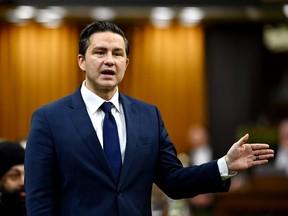BANFF, Alta. – A popular selfie spot for visitors to Banff National Park has become a victim of its own success.
The two-metre-high, $350,000 “Banff” sign was installed in 2017 on Mount Norquay Avenue, one of two entrances into the Alberta mountain park’s idyllic townsite.
But the narrow two-lane road, which runs from the Mount Norquay Ski Resort seven kilometres away, is fraught with traffic jams, even between the peak tourist seasons of winter and summer.
Town officials have decided it needs to be moved.
“We’ve debated this for over three years now,” said Darren Enns, Banff’s director of planning and environment. “We’ve finally reached the point that we made the decision to take the next step forward.”
Banff gets about four million visitors a year, and Mount Norquay Avenue sees 55 to 60 per cent of the traffic, said Enns.
In the summer, there are about 17,000 vehicles a day on the avenue, with lots of pedestrians crossing the road from a parking lot to the sign.
“We’re very fortunate to not have any public safety incidents. But certainly that’s always top of mind, and our council has directed us to look at a more pedestrian-oriented environment for the sign,” said Enns, adding a move could happen as early as next summer.
On a recent sunny day in October, a steady stream of visitors made their way from across the road to the sign, causing traffic to stop.
A lineup of about 30 people waited for a chance to take photos, many offering to snap shots for others.
Mike Jones and his wife were among those in line.
“It’s something we always do when we go to a touristy place. We always like to have a memory of wherever we’re visiting, whether it’s Banff or somewhere else. It’s kind of what we do and I know a lot of others think the same way,” said Jones, who is from Fort McMurray.
He was surprised to hear the sign will be moving but said it’s likely the right call.
“I’m sure they’ll pick a good spot and a safe spot,” he said. “If it’s causing an issue, they do have to move it.”
Alissa Kittelson, her husband and two daughters were visiting from Minneapolis.
“Banff was on my bucket list. It’s beautiful. I’ve seen photos and I wanted to come and check it out. I hope it makes the Christmas card,” Kittelson said.
She was glad to get the family photo before the landmark is moved.
“I feel like it’s the perfect spot. We’re right on the edge of town. You can see the beautiful mountains behind it. You can see the beautiful trees. I’d be sad to see it moved.”
Enns said there are a couple of places where the sign could find a new home, including a downtown park. But the most likely location is a kilometre away at the Banff train station, where there are about 450 parking stalls.
“It’s always great to see a project that is so successful that it has unintended consequences around it,” Enns said.
“I’m very grateful for all the interactions we’ve been able to provide our visitors and all the memories that we’ve been able to create.”
This report by The Canadian Press was first published Oct. 27, 2024.
